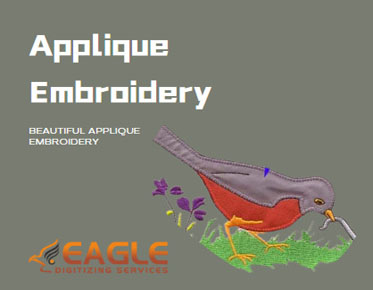Appliqué Essentials: Embroidery Digitizing Guide
What is Appliqué Embroidery Digitizing?
Appliqué embroidery digitizing is a fascinating technique that combines fabric pieces with embroidery to create layered, textured designs. It's a method where fabric shapes are cut out and sewn onto a larger piece of fabric, with the edges typically finished with embroidery stitches. Digitizing this process involves using specialized software to create embroidery designs that can be executed by an embroidery machine.
Why Appliqué is a Game Changer in Embroidery
Appliqué opens up a world of possibilities in embroidery. It allows for the creation of complex designs without the need for dense stitching, making it a time-efficient and cost-effective method. The technique adds dimension and texture to embroidery projects, transforming simple designs into intricate masterpieces. By integrating various fabrics and textures, appliqué offers endless creative potential.
Getting Started with Appliqué
Essential Tools and Materials for Appliqué
To begin your appliqué journey, you’ll need a few essential tools: an embroidery machine, digitizing software, embroidery hoops, scissors, fabric glue, stabilizers, and a variety of fabrics. A cutting mat and rotary cutter can also be invaluable for precise fabric cutting. Additionally, ensure you have high-quality embroidery thread to complement your fabric choices.
Choosing the Right Fabric for Your Appliqué
Selecting the right fabric is crucial for successful appliqué. Opt for fabrics that don’t fray easily, like cotton or felt. For intricate designs, lightweight fabrics work best as they are easier to manipulate. For a more dramatic effect, mix and match textures such as satin, velvet, and denim. The key is to choose fabrics that complement each other and the overall design.
Selecting the Perfect Design for Appliqué Digitizing
When choosing a design for appliqué digitizing, consider the complexity and the number of layers. Simple, bold shapes work well for beginners, while more experienced embroiderers can experiment with detailed patterns. Look for designs that can be broken down into individual sections, making the digitizing and stitching process more manageable.
Understanding the Process
How Appliqué Embroidery Digitizing Works
The digitizing process starts with selecting or creating a design in digitizing software. This software converts your design into a digital file that an embroidery machine can read. The design is broken down into steps, starting with the placement line, followed by the tackdown line, and finally, the stitch line that secures the appliqué fabric.
Step-by-Step Overview of the Appliqué Process
1. Prepare your design: Scale and adjust the design to fit your project.
2. Digitize the design: Use digitizing software to create the placement, tackdown, and stitch lines.
3. Transfer the design: Print the template and prepare your fabric.
4. Cut the appliqué pieces: Use cutting machines or scissors for precision.
5. Hoop the fabric: Align and hoop your fabric correctly.
6. Stitch the design: Follow the digitized steps to complete the appliqué.
Preparing Your Design
Scaling and Adjusting Your Design for Appliqué
Accurate scaling ensures your design fits perfectly on the intended fabric. Use digitizing software to adjust the size of each design element. Keep the proportions in mind to avoid distorting the design. Always print a test template to check the scale before transferring it to fabric.
Creating Your Design in Digitizing Software
Open your design in digitizing software and trace the outlines. Define the placement line, which marks where the fabric pieces will be placed. Add the tack-down line to temporarily hold the fabric in place, followed by the final stitch line to secure the edges. Experiment with different stitch types to add variety and texture.
Adding Appliqué Layers in Your Design
Layering adds depth and interest to your appliqué designs. In your digitizing software, create separate layers for each fabric piece. Ensure each layer is digitized with its own placement, tackdown, and stitch lines. Carefully plan the sequence of layers to achieve the desired effect.
Types of Appliqué Stitches
Satin Stitches: The Classic Choice
Satin stitches are smooth and dense, providing a polished finish to appliqué edges. They are ideal for outlining shapes and adding a professional touch. Adjust the stitch width to suit the size of your design for the best results.
Zigzag Stitches for a Bold Look
Zigzag stitches offer a bold, less dense alternative to satin stitches. They are quicker to stitch and add a playful, dynamic feel to your appliqué. Vary the stitch width and density to create different effects.
Blanket Stitches for a Handcrafted Feel
Blanket stitches mimic hand-sewn edges, adding a rustic, handmade aesthetic to your appliqué. They are perfect for designs that require a softer, more traditional look. Experiment with different thread colors to enhance the visual appeal.
Decorative Stitches: Adding Extra Flair
Decorative stitches bring a unique touch to appliqué. Use them to add intricate details and patterns along the edges of your fabric pieces. Most digitizing software offers a variety of decorative stitches, allowing you to customize your designs further.
Digitizing Your Appliqué Design
Setting Up Your Design File
Begin by setting up a new design file in your digitizing software. Import your design and organize it into layers. Define the sequence of steps, ensuring the placement, tackdown, and final stitch lines are correctly ordered. Save your file in a format compatible with your embroidery machine.
Digitizing the Placement Line
The placement line marks where each fabric piece will go. Use a running stitch to create a clear outline. This line will be stitched first, guiding you on where to place your fabric pieces.
Digitizing the Tackdown Line
The tack-down line temporarily holds the fabric in place. Use a running or zigzag stitch to secure the fabric after it’s positioned. This step is crucial for keeping the fabric stable during the final stitching.
Digitizing the Final Stitch Line
The final stitch line secures the edges of the appliqué fabric. Use a satin stitch or other decorative stitches to cover the raw edges completely. Ensure this line is tight and even for a polished finish.
Using Digitizing Software
Overview of Popular Digitizing Software
Several digitizing software options are available, each with its features. Popular choices include Wilcom, Hatch, Brother PE-Design, and Janome Digitizer. Each software has unique tools and capabilities, so choose one that fits your needs and skill level.
Basic Tools and Features You’ll Use
Familiarize yourself with basic tools like the selection tool, shape tool, and stitch tool. Learn to use features such as auto-trace, manual digitizing, and stitch preview. These tools help create precise and professional designs.
Tips for Efficient Digitizing
Work systematically, starting with simple shapes and gradually adding details. Use keyboard shortcuts to speed up the process. Regularly save your work to avoid losing progress. Practice different techniques to find the most efficient workflow for your projects.
Transferring Your Design to Fabric
Printing Your Design Template
Print your design template to use as a guide for cutting and placing fabric pieces. Ensure the template is to scale and includes all necessary markings. Use high-quality paper and print settings for clarity.
Preparing Your Fabric for Appliqué
Wash and iron your fabric to remove any wrinkles or shrinkage. Apply a stabilizer to the back of the fabric to prevent stretching and distortion during stitching. Choose a stabilizer suitable for your fabric type and design complexity.
Aligning and Hooping Your Fabric
Place the fabric in the embroidery hoop, ensuring it’s taut and centered. Align the printed template with the placement lines on the fabric. Secure the fabric in the hoop, adjusting the tension to prevent movement during stitching.
Cutting Your Appliqué Pieces
Methods for Cutting Appliqué Pieces
Cutting accurately is essential for clean appliqué designs. Use sharp scissors, rotary cutters, or precision cutting machines. Templates can help ensure uniformity, especially for complex shapes.
Using Cutting Machines for Precision
Cutting machines like Cricut or Silhouette offer precision and efficiency. Create digital cut files from your design and let the machine do the work. This method is ideal for intricate designs and multiple pieces.
Hand-Cutting Tips for Appliqué
If cutting by hand, use small, sharp scissors for intricate shapes. Mark your fabric with a light pencil or chalk before cutting. Take your time to ensure clean, precise edges.
Stitching Your Appliqué
Setting Up Your Embroidery Machine
Set up your embroidery machine according to the manufacturer’s instructions. Select the proper needle and thread for your cloth. Load your digitized design file and check the settings.
Stitching the Placement Line
Stitch the placement line first to outline where each fabric piece will go. Ensure the line is clear and precise, as it guides the placement of your appliqué pieces.
Securing the Appliqué Fabric with the Tackdown Line
Position the fabric pieces on the placement line and stitch the tack down line to hold them in place. Ensure the fabric is flat and smooth to avoid puckering.
Finishing with the Final Stitch Line
Stitch the final line to secure the fabric edges. Use a satin stitch or decorative stitch to cover raw edges and add a professional finish. Check for any gaps or loose threads and make necessary adjustments.
Troubleshooting Common Issues
Dealing with Misaligned Appliqué Pieces
If appliqué pieces are misaligned, carefully remove the stitches and reposition the fabric. Use fabric glue or temporary adhesive to keep the pieces in place before re-stitching.
Fixing Gaps in the Stitch Line
Gaps in the stitch line can occur if the fabric shifts. Check the tension settings on your machine and ensure the fabric is secure in the hoop. Add additional stitches if necessary to close any gaps.
Ensuring Your Stitches Are Secure
Secure stitches by backstitching at the beginning and end of each line. Use high-quality thread to prevent breakage. Regularly check your machine’s tension settings and adjust as needed.
Appliqué embroidery digitizing in USA combines fabric pieces with embroidery to create textured, layered designs. It involves selecting designs, digitizing, cutting, and stitching. This versatile technique offers endless creative possibilities.
Don’t be afraid to experiment with different fabrics, stitches, and techniques. Innovation is key to creating unique, personalized designs. The more you practice and experiment, the more comfortable and skilled you will become.



